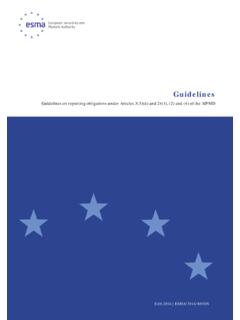Transcription of Quantum Physics III Chapter 1: Non-degenerate and ...
1 Chapter 1 Perturbation theoryc B. ZwiebachIt is often the case that the Hamiltonian of a system differs slightly from a Hamiltonianthat is well studied and completely understood. This is a situation where perturbation the-ory can be useful. Perturbation theory allows us to make statements about the Hamiltonianof the system using what we know about the well studied well studied Hamiltonian could be the that of the simple harmonic oscillator in one,two, or three dimensions. In a diatomic molecule, for example, the potential that controlsthe vibrations is not exactly quadratic; it has extra terms that make the vibrations slightlyanharmonic. In that situation the extra terms in the potential represent perturbations of theHamiltonian. The hydrogen atom Hamiltonian is also a well understood system. If we placethe atom inside a weak external magnetic field or electric field, the situation is described byadding some small terms to the hydrogen Hamiltonian.
2 Similarly, the interaction betweenthe magnetic moments of the proton and the electron can be incorporated by modifying theoriginal hydrogen atom Hamiltonian. The interaction between two neutral hydrogen atomsat a distance, leading to the van der Waals force can be studied in perturbation theory bythinking of the two atoms as electric Hamiltonian of interest is written as the understood, original HamiltonianH(0),plus a perturbation H:H(0)+ H .( )SinceH(0)is Hermitian and the sum must be a Hermitian Hamiltonian, theperturbationoperator Hmust also be Hermitian. It is convenient to introduce a unit-free constant [0,1] and to consider, instead, a -dependent HamiltonianH( ) that takes the formH( ) =H(0)+ H .( )When = 1 we have the Hamiltonian of interest, but allows us to consider a family ofHamiltonians that interpolate fromH(0), when is equal to zero, to the Hamiltonian ofinterest for equal to one.
3 In many cases perturbations can be turned on andoff; think,12 Chapter 1. TIME INDEPENDENT PERTURBATION THEORYfor example, of an atom in an external magnetic field that can be varied continuously. Inthat case we can view as the parameter that allows us to turn on the perturbation byletting 6= 0. The parameter is also useful in organizing the perturbation analysis, as wewill see spoke of a Hamiltonian that differs slightly fromH(0). In order to use perturbationtheory we need Hto be a small perturbation of the HamiltonianH(0). We will have todeal with the meaning of small. At first sight we may imagine that small means that, viewedas matrices, the largest entries in Hare smaller than the largest entries inH(0). Whilethis is necessary, more is needed, as we will see in our analysis. An additional advantage ofusing is that by taking it to be sufficiently small we can surely make assume that the HamiltonianH(0)is understood, namely, we know the eigenstatesand eigenvalues ofH(0).
4 We want to know the eigenstates and eigenvalues ofH( ). One maybe able to calculate those exactly, but this is seldom a realistic possibility. Diagonalizing His seldom useful, since HandHdo not generally commute and therefore Heigenstates arenot eigenstates ofH( ). In perturbation theory the key assumption is that the eigenvaluesand eigenvectors ofH( ) can be found as series expansions in powers of . We hope, ofcourse, that there are some values of for which the series converges, or at least gives :The energy eigenvalues ofH( ) as varies from zero to one. On the = 0 verticalaxis theH(0)eigenstates are represented by heavy dots. By the time = 1 the dots have Figure we illustrate some of the phenomena that we may see in the spectrumof a system with HamiltonianH( ). We show how the energies of the various states maychange as the parameter is increased from zero.
5 The two lowest energy eigenstates arenon-degenerate and their energies can go up and down as varies. Next up in energy wehave two degenerate states ofH(0)(the Hamiltonian as = 0). The perturbation splits NONDEGENERATE PERTURBATION THEORY3two levels, and that happens generically. In the figure, the perturbation splits the levels tofirst order in , as shown by the different slopes of the two curves that meet at = 0. Inother words, viewed as power series in the energies of the two states have different linearterms in . The last level shown corresponds to four degenerate states. The perturbationto first order in splits the states into a group of three states and a fourth. Tosecond orderin the three states split further. A single Hamiltonian can exhibit behavior like this, withmany possible analyze the evolution of states and energies as functionsof we have two possiblecases: (i) we are following a Non-degenerate state or, (ii) we are following a collection ofdegenerate states.
6 The challenges are quite different and therefore we must analyze themseparately. Clearly both situations can occur for a single Hamiltonian, depending on thespectrum ofH(0). To follow a Non-degenerate state we usenon-degenerate perturbationtheory. To follow a set of degenerate states we usedegenerate perturbation theory. SinceHamiltoniansH(0)generally have both Non-degenerate and degenerate states we need toconsider both types of perturbation theory. We begin with Non-degenerate Nondegenerate perturbation theoryWe begin by describing the original HamiltonianH(0). We assume this Hamiltonian has adiscrete spectrum with an orthonormal basis|k(0)iof energy eigenstates, wherek Zis alabel that ranges over a possibly infinite set of values:H(0)|k(0)i=E(0)k|k(0)i,hk(0)|l(0) i= kl.( )We will letk= 0 denote the ground state and we order the states so that the energiesgenerally increase as the value of the label increases, so thatE(0)0 E(0)1 E(0)2 E(0)3.
7 ( )The equal signs are needed because some states may be this section we focus on a Non-degenerate state|n(0)iwith fixedn. This means that|n(0)iis a single state that is separated by some finite energy from all the states with moreenergy and from all the states with less energy. In other words the following must be partof the sequence of inequalities in ( ).. E(0)n 1< E(0)n< E(0)n+1 ..( )If the chosen state is the ground state, we have insteadE(0)0< E(0) the perturbation is turned on by making different from zero, the energy eigenstate|n(0)iofH(0)will evolve into some energy eigenstate|ni ofH( ) with energyEn( ):H( )|ni =En( )|ni ,( )4 Chapter 1. TIME INDEPENDENT PERTURBATION THEORY where|ni =0=|n(0)i,andEn( = 0) =E(0)n.( )As we said, the solution is assumed to take the form of a regular power series expansionin.
8 To make this clear consider a functionf( ) such that its derivatives to all orders existfor = 0. In that case we have a Taylor expansionf( ) = Xn=01n!f(n)(0) n=f(0) +f (0) +12f (0) 2+13!f (0) 3+ ( )The expansion is a power series in , with coefficientsf(0),f (0),etc, that are independentand reflect the value of the function and its derivatives at = our problem we note the values of|ni andEn( ) for = 0 ( ) and write:|ni =|n(0)i+ |n(1)i+ 2|n(2)i+ 3|n(3)i+.. ,En( ) =E(0)n+ E(1)n+ 2E(2)n+ 3E(3)n+..( )The superscripts on the states and energies denote the powerof that accompanies themin the above expressions. The above equations are a natural assumption; they state thatthe perturbed states and energies, being functions of , admit a Taylor expansion around = 0. Our aim is to calculate the states|n(1)i,|n(2)i,|n(3)i.
9 ( )and the energiesE(1)n, E(2)n, E(3)n, ..( )Note that all these states and energies are, by definition, independent. Here|n(1)iis theleading correction to the state|n(0)ias we turn on , andE(1)nis the leading correction tothe energy as we turn on . We willnotimpose the requirement that|ni is normalized. Itsuffices that|ni is normalizable, which it will be for sufficiently small perturbations. For = 1 we would find the solution forH(1) =H(0)+ Hin the form|ni |ni1=|n(0)i+|n(1)i+|n(2)i+|n(3)i+.. ,En En(1) =E(0)n+E(1)n+E(2)n+E(3)n+..( )Substituting the ansatz ( ) into the Schr odinger equation ( ) we will find theconditions for such solution to exist: H(0)+ H En( ) |ni = 0,( )which more explicitly takes the form (H(0) E(0)n) (E(1)n H) 2E(2)n 3E(3)n .. kE(k)n+.. |n(0)i+ |n(1)i+ 2|n(2)i+ 3|n(3)i+.
10 + k|n(k)i+.. = 0.( ) NONDEGENERATE PERTURBATION THEORY5 Multiplying out we get a series in with coefficients -independent vectors in the statespace of the theory. If this is to vanish for all values of those coefficients must be the coefficients for each power of we 0: (H(0) E(0)n)|n(0)i= 0, 1: (H(0) E(0)n)|n(1)i= (E(1)n H)|n(0)i, 2: (H(0) E(0)n)|n(2)i= (E(1)n H)|n(1)i+E(2)n|n(0)i, 3: (H(0) E(0)n)|n(3)i= (E(1)n H)|n(2)i+E(2)n|n(1)i+E(3)n|n(0)i,.. k: (H(0) E(0)n)|n(k)i= (E(1)n H)|n(k 1)i+E(2)n|n(k 2)i+..+E(k)n|n(0)i.( )Each equation is the condition that the coefficient multiplying the power of indicated tothe left vanishes. That power is reflected as the sum of superscripts on each term, counting Has having superscript one. This gives a simple consistency check on our equations. Theseare equations for the kets|n(1)i,|n(2)i.













